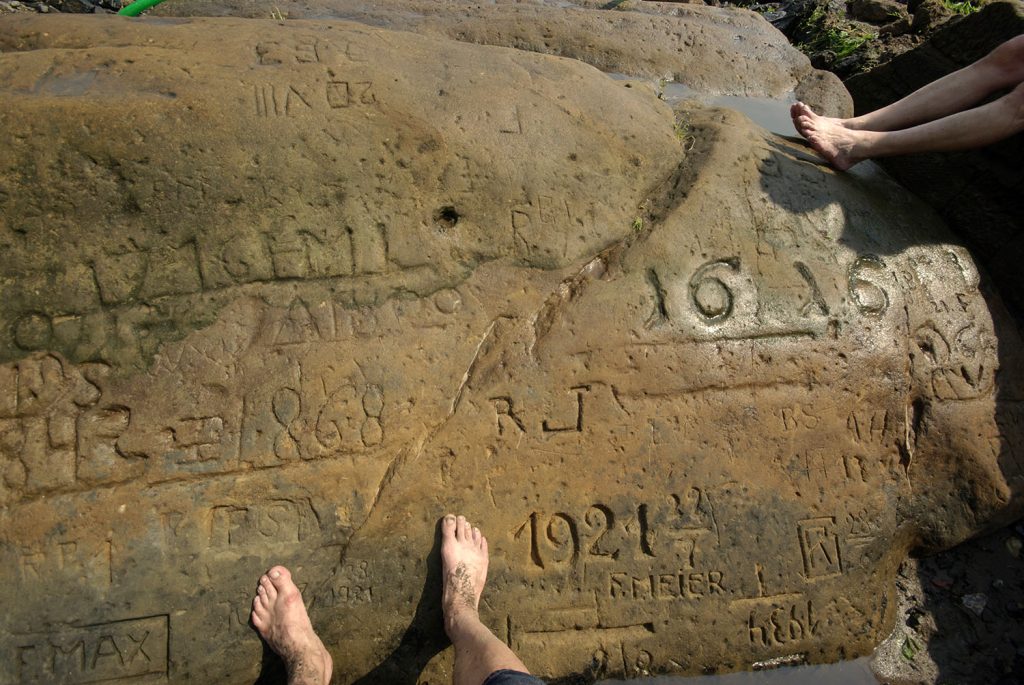
Today I learned about “hunger stones“. These are rocks in the River Elbe that are submerged in all but the lowest water conditions. Carvings on them commemorate historical droughts back to the fifteenth century and warn that if the stone is visible, famine will follow. One of the most poignant inscriptions translates as “If you see me, weep”. As Europe faces what may be its worst drought in 500 years, these stones are appearing… and while famine is less inevitable in a world of globalised food supply, it’s interesting to see the knock-on effects on energy.
Shipping companies have been warning for some time that water levels on Europe’s rivers have been approaching a level at which cargo traffic would have to stop. Indeed, when I was sitting by the Rhine on holiday two weeks ago I noticed that the laden barges were sitting higher in the water than usual – that they were sailing with reduced loads to cope with a shallower river. Since then parts of the river have effectively closed as predicted, as shipping companies decide that there is not enough water to operate safely or economically.
The closure of major transport routes is concerning for supply chains in general, but one of the major cargos carried by these rivers into inland Europe is coal, for power stations. So a shortage of water can translate to a shortage of energy.
Over in France, meanwhile, the country’s major rivers are at historically low flow rates… and that, combined with high water temperatures from this summer’s heatwave, has obliged nuclear power stations that rely on rivers for cooling to reduce their output to comply with environmental regulations. With reduced outputs on top of a lot of maintenance shutdowns this year, the country most famous for embracing nuclear power has become an energy importer.
Norway is another nation that is traditionally energy-independent: while they do have a lot of oil and gas, they use little of it domestically because their electrical grid runs almost entirely off hydro power, and on top of the fossil fuels they are usually a net exporter of clean electricity. But without rainfall there’s less hydro power, and with their reservoirs at unseasonally low levels the Norwegian authorities are considering restricting electricity exports to protect their domestic supply.
None of that affects the UK directly: we don’t use inland waterways for cargo, our nuclear plants are all on the coast, and we only have a small amount of hydroelectricity. But the knock-on effects of a worsening energy shortage in Europe will certainly be felt here, in the form of higher wholesale energy prices.
I mention all of these things together because they’re a clear demonstration of the interconnectedness of the systems that we take for granted. Our power and other industrial infrastructure was designed for the time in which it was built, plus forseeable changes – and nobody (a figurative nobody) foresaw parts of the Loire running dry, or the Rhine becoming impassable to coal barges.
This is a part of something sometimes referred to as the “Energy-water nexus“: the idea that energy supplies depend on water, and water supplies depend on energy, and that developing more of one usually requires more of the other. It’s interesting to think about whether this interdependence might be weakened by increasing use of renewable energy. Wind and solar probably rely on water less than thermal plants do… but in the future, will we see drought-related curtailment of freshwater hydrogen production?

[…] An earlier version of this article first appeared on the author’s blog. […]
[…] An earlier version of this article first appeared on the author’s blog. […]
[…] An earlier version of this article first appeared on the author’s blog. […]
[…] An earlier version of this article first appeared on the author’s blog. […]
[…] An earlier version of this article first appeared on the author’s blog. […]
[…] An earlier version of this article first appeared on the author’s blog. […]
[…] An earlier model of this text first appeared on the creator’s weblog. […]
[…] An earlier version of this article first appeared on the author’s blog. […]
[…] An earlier version of this article first appeared on the author’s blog. […]
[…] An earlier version of this article first appeared on the author’s blog. […]
[…] An earlier version of this article first appeared on the author’s blog. […]